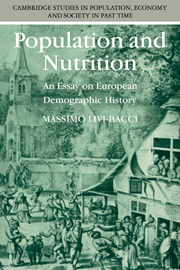Book contents
- Frontmatter
- Contents
- List of figures
- List of tables
- Preface
- 1 Demographic growth in Europe
- 2 Energy, nutrition and survival
- 3 Famine and want
- 4 The starving and the well-fed
- 5 Food and standard of living: hypotheses and controversies
- 6 Antagonism and adaptation
- Notes
- General index
- Cambridge Studies in Population, Economy and Society in Past Time
6 - Antagonism and adaptation
Published online by Cambridge University Press: 20 October 2009
- Frontmatter
- Contents
- List of figures
- List of tables
- Preface
- 1 Demographic growth in Europe
- 2 Energy, nutrition and survival
- 3 Famine and want
- 4 The starving and the well-fed
- 5 Food and standard of living: hypotheses and controversies
- 6 Antagonism and adaptation
- Notes
- General index
- Cambridge Studies in Population, Economy and Society in Past Time
Summary
Constraints and biological adaptation
The vicissitudes of Europe's populations – as, indeed, those of all populations in all periods – have been dominated by continuous friction between the forces of constraint and the capacity to adapt. By forces of constraint we mean, broadly speaking, environmental factors: geophysical configuration, climate, availability of land, food production and epidemic attacks. These constraining forces hinder that ideal demographic development which might be expected in a kind of Eden with unbounded food resources, limitless land, perfect climate and a total absence of hostile, pathogenic micro-organisms. It is possible to modify these constraints, but never quickly and never completely. Every community must come to terms with them, moulding and adapting its behaviour and, to some extent, its biological characteristics accordingly.
Scarcity of food is one of the chief obstacles, since it acts as a check on growth by boosting mortality or checking nuptiality along the lines of the Malthusian model discussed in the first chapter. The relationship of resources to survival is one of antagonism, mitigated, however, by the capacity of every demographic group to adapt both biologically and culturally. Cultural adaptation has manifested itself in a number of complex ways, sometimes passive but more often active, which entail with agricultural developments the production, exchange, preservation and preparation of food. Social and economic historians have dwelt at length on these types of adaptation.
- Type
- Chapter
- Information
- Population and NutritionAn Essay on European Demographic History, pp. 111 - 121Publisher: Cambridge University PressPrint publication year: 1991

